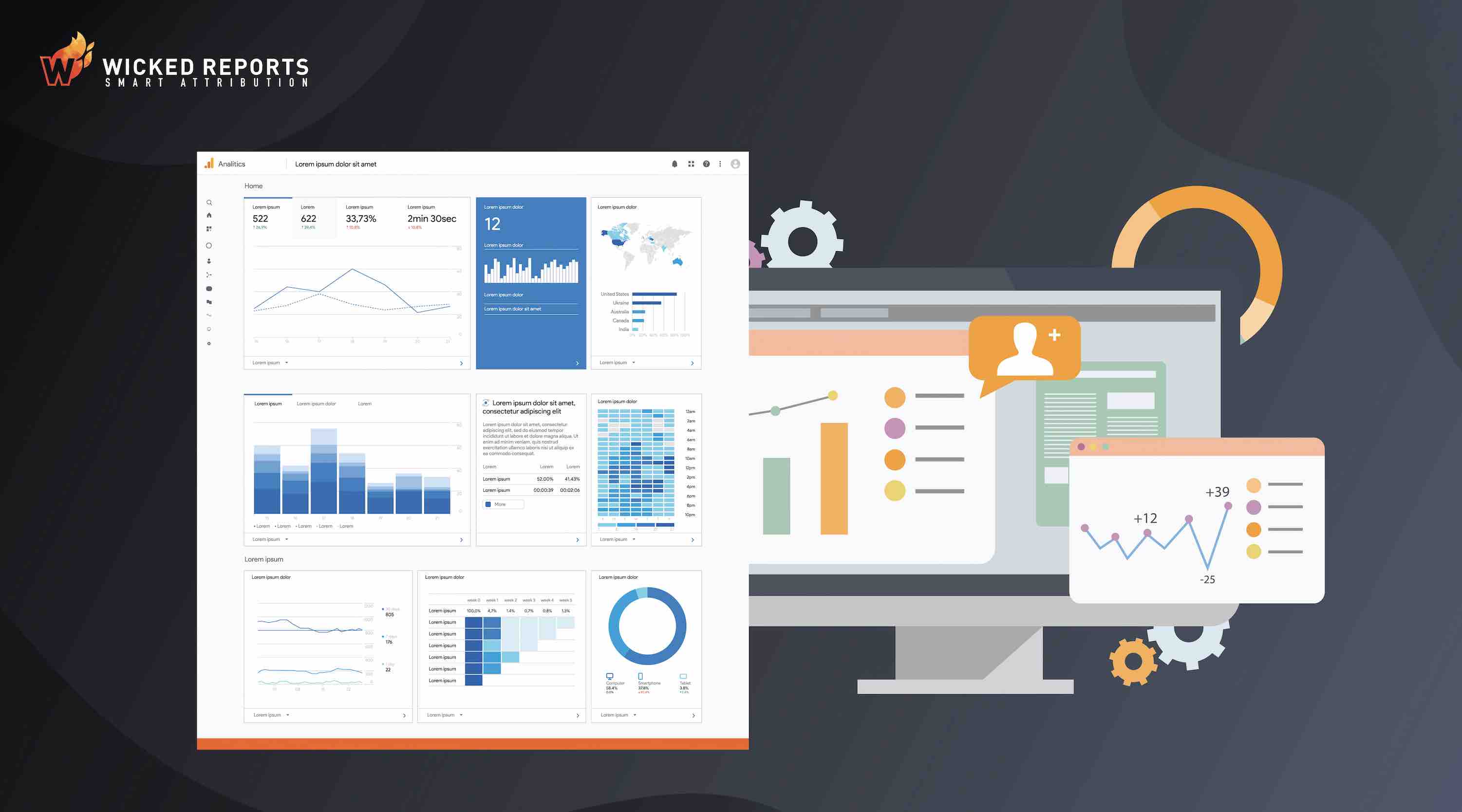2 min read
Why High Meta ROAS Doesn't Always Equal More Revenue
Jan 8, 2026 by Scott Desgrosseilliers
2 min read
How to Double New Customers While Reducing Ad Spend
Jan 6, 2026 by Scott Desgrosseilliers
4 min read
Drowning in Dashboards? Why You Need Better Decisions, Not More Data
Dec 31, 2025 by Scott Desgrosseilliers
4 min read
The Most Important Metric in Your Business (and Why You Aren’t Tracking it Correctly)
Dec 29, 2025 by Scott Desgrosseilliers
4 min read
The 3 Mistakes Killing Your Top-of-Funnel Performance - A Wicked Reports Deep Dive
Dec 26, 2025 by Scott Desgrosseilliers
4 min read
Why Your ROAS Is Lying to You (and How to Fix It in 48 Hours)
Dec 24, 2025 by Scott Desgrosseilliers
4 min read
The Fastest Path to Lower nCAC: Fix the Meta Signal, Not the Creatives
Dec 22, 2025 by Scott Desgrosseilliers
4 min read
The Growth Ceiling Trap: Why Meta Rewards the Wrong Campaigns and How to Fix the Bias
Dec 19, 2025 by Scott Desgrosseilliers
4 min read
Stop Wasting 40% of Ad Spend on Existing Customers
Dec 17, 2025 by Scott Desgrosseilliers
4 min read
The Hidden Cost of Bad Attribution: Quantify the Risk
Dec 15, 2025 by Scott Desgrosseilliers
4 min read
The Retargeting Trap: More New Customers on Half the Spend
Dec 12, 2025 by Scott Desgrosseilliers
4 min read
Stop Waiting. Start Scaling. Our Latest Platform Updates Are Live!
Dec 11, 2025 by Scott Desgrosseilliers
4 min read
The Direct Conversion Black Hole: Why 40% of Your Revenue Is Untracked (And How to Fix It)
Dec 11, 2025 by Scott Desgrosseilliers
4 min read
Eternal Tracking: Why 7-Day Cookies Kill Ecommerce Growth
Dec 9, 2025 by Scott Desgrosseilliers
4 min read
How Huha Scaled from $1M to $30M Escaping the 8Figure Attribution Trap
Dec 5, 2025 by Scott Desgrosseilliers
6 min read
How the Pros Report PPC Success: 5 Proven Strategies
By Scott Desgrosseilliers on Apr 2, 2025 10:58:26 AM
Marketing attribution models are now a crucial tool for businesses looking to optimize their marketing strategy and maximize return on investment. As a marketer with years of experience, I've seen how these models can transform decision-making processes and drive real results. Understanding and implementing marketing attribution models can be a complex task. Especially for those new to the concept.
Topics: attribution models attribution windows Attribution Health multi-touch attribution Meta ads measurement PPC reporting performance marketing
6 min read
How To Use Marketing Attribution Models To Increase Marketing ROI
By Katie Switzer on Jun 27, 2022 4:14:02 PM
Update: Click to learn more about FunnelVision here.
Understanding different attribution models and how to use them is critical to marketers looking to increase ROI on ecommerce brand advertising.
Attribution models are powerful because they make it easy to spot what campaigns are not performing, and which campaigns should get more ad spend.
Data is collected when a user first clicks on an ad, the user begins to be tracked, data is recorded, that data can be sent back to Facebook or Google This data collection and attribution process continues from that first-click to every interaction thereafter, crediting campaigns with revenue from sales.
There are four main types of marketing attribution models:
- First Click ROI
- First Opt-in ROI
- Last-Click ROI
- Re Engaged Leads ROI
- Multi-Touch (Full Impact and Linear) ROI
Each of these models is used to evaluate marketing performance at different levels of the sales funnel.
Using them strategically in combination with each other is critical for developing a high ROI for paid advertising at every stage of user interaction. They make it easy to determine what content is performing (and what isn't) so you can eliminate the fluff and focus your efforts and budget on what converts.
First Click ROI Attribution Model
First-click attribution is just that - it gives all the credit for a sale to the very first click a user makes.
This is best used to identify what campaigns are performing best for cold traffic (TOF).
You might think that you need to optimize cold traffic for clicks or leads. This is a common misconception about TOF optimization.
But the most successful brands know that the highest ROI comes from optimizing cold traffic for purchases. Not just any purchases - high value customers.
This can be done a couple of ways. The most common methods for optimizing on LTV we see is brands dive into their customer LTV reporting and create lookalike audiences and replicate the content that inspired their highest value customers to make purchases.
This one small strategist shift around optimizing cold traffic can make an enormous difference in your ROI throughout the entire sales funnel. Try it and see the results for yourself.
Re Engaged Lead ROI Attribution Model
Re-Engaged Leads are critical for keeping your list engaged, improving deliverability, and increasing ROI through repeat purchases.
The Re-Engaged Lead ROI Attribution Model credits all revenue to re-optin content from MOF.
It's useful for optimizing MOF for content that engages users, inspires new or repeat purchases, and keeping your brand in the front of people's minds.
Use this model to eliminate MOF content that isn't performing. The benefits of this are increasing ROI by reducing buying cycle time. Buying cycle is the time it takes from first-click or lead opt-in to a purchase. Reducing this time makes you ROI positive in a shorter time frame, recouping your advertising costs faster and potentially bringing in more sales from repeat customers.
Reducing the buying cycle time can be pretty powerful for your bottom line.
All you have to lose by optimizing MOF with a ReEngaged Lead ROI Attribution Model is negative ROI campaigns!
Last Click ROI Attribution Model
Crediting all the revenue to the final click before purchases gets you a clear image of what content is inspiring users to become customers.
The Last-Click ROI Attribution Model makes it easy to identify positive ROI campaigns or channels. Then you can add budget to scale those campaigns and increase overall revenue.
Negative ROI campaigns should be killed - but hold on! Before you do, let's talk about buying cycle time a little bit more.
We talked about reducing buying cycle time by eliminating MOF content that doesn't perform using ReEngaged Lead ROI.
But how long should you let a new campaign run before pulling the plug?
Amateur marketers will often turn a campaign off after only 3 days (or less). This is a critical mistake - they are likely killing campaigns that just haven't had time to build value yet.
The best way to check buying cycle time for your brand is to use a Sales Velocity Report. You can check the buying cycle time from first click or lead to sale using one of these.
Now it becomes easy to decide how long to run a campaign before you kill it or scale it. This is especially helpful with last-click campaigns at the BOF, which take the longest to convert because they are by definition at the end of the buying cycle.
To optimize paid advertising, your brand needs accurate, multi-touch attribution data and a clear measurement of buying cycle time.
Multi-Touch Marketing Attribution Models
Multi-Touch Marketing Attribution Models credit revenue across multiple touch points, rather than a single step of your funnel (like first- and last-click models). This is insightful for taking a 10,000 foot view of marketing performance, making it easy to identify which steps in your marketing funnel are performing well and which need a little TLC.
We love using these to get an idea of where to dive into the details on funnel steps, channels, and individual campaign performance using the other attribution models previously discussed.
We use two different multi-touch marketing attribution models to help our clients scale their paid advertising performance. Our Linear ROI Attribution Model credits revenue fractionally across as many as four touch points, which helps to highlight strong and weak areas across your marketing funnel. The Full Impact Attribution Model credits full revenue at each of four touch points, which makes it much easier to see the highs and lows.
Multi-touch attribution models offer incredible insights into your marketing performance that just cannot be found anywhere else.
You can find out more about Linear and Full Impact ROI Attribution models here.
How To Optimize Ecommerce ROI From Paid Ads Using Marketing Attribution Models
Marketing Attribution Models with accurate attribution data are a game changer for ecommerce brands looking to increase their ROI.
The most important ways to use these models to optimize are:
- Multi-touch Attribution Models are the best place to start with a high level view of marketing performance.
- Use First-Click ROI Attribution to optimize your cold traffic for high value customers, not clicks or leads.
- Keep email subscribers and retarget audiences engaged, and increase ROI by tracking ReEngaged Lead ROI and replicating or scaling effective content.
- Last-Click ROI Attribution is best used to scale BOF ads for actual purchases and customer LTV.
- Allow campaigns to run for at least one buying cycle before deciding to kill, chill, or scale.
You can bring all these tools together using the Wicked Reports dashboard, to get the most out of accurate, multi-touch marketing attribution.
faq
What are the main types of marketing attribution models discussed?
The main models include First Click ROI, First Opt-in ROI, Last-Click ROI, Re Engaged Leads ROI, and Multi-Touch ROI (Full Impact and Linear).
How should the First Click ROI Attribution Model be used?
It should be used to optimize cold traffic (TOF) for high-value purchases, not just clicks or leads. This is often done by creating lookalike audiences based on high Customer Lifetime Value (LTV) customers.
Why is it important to know your brand's buying cycle time?
Knowing your buying cycle time (which can be checked with a Sales Velocity Report) helps you determine the necessary duration to run a new campaign before you decide to "kill, chill, or scale" it, preventing the premature ending of potentially valuable campaigns.
Book a call with a Wicked Attribution Expert to see what Marketing Attribution Models can do for you!
Topics: Wicked Reports attribution models attribution marketing attribution ROI Marketing Attribution
13 min read
Marketing Attribution 2020: Tracking ROI & LTV Across Platforms
By Scott Desgrosseilliers on Jun 1, 2020 9:19:02 AM




